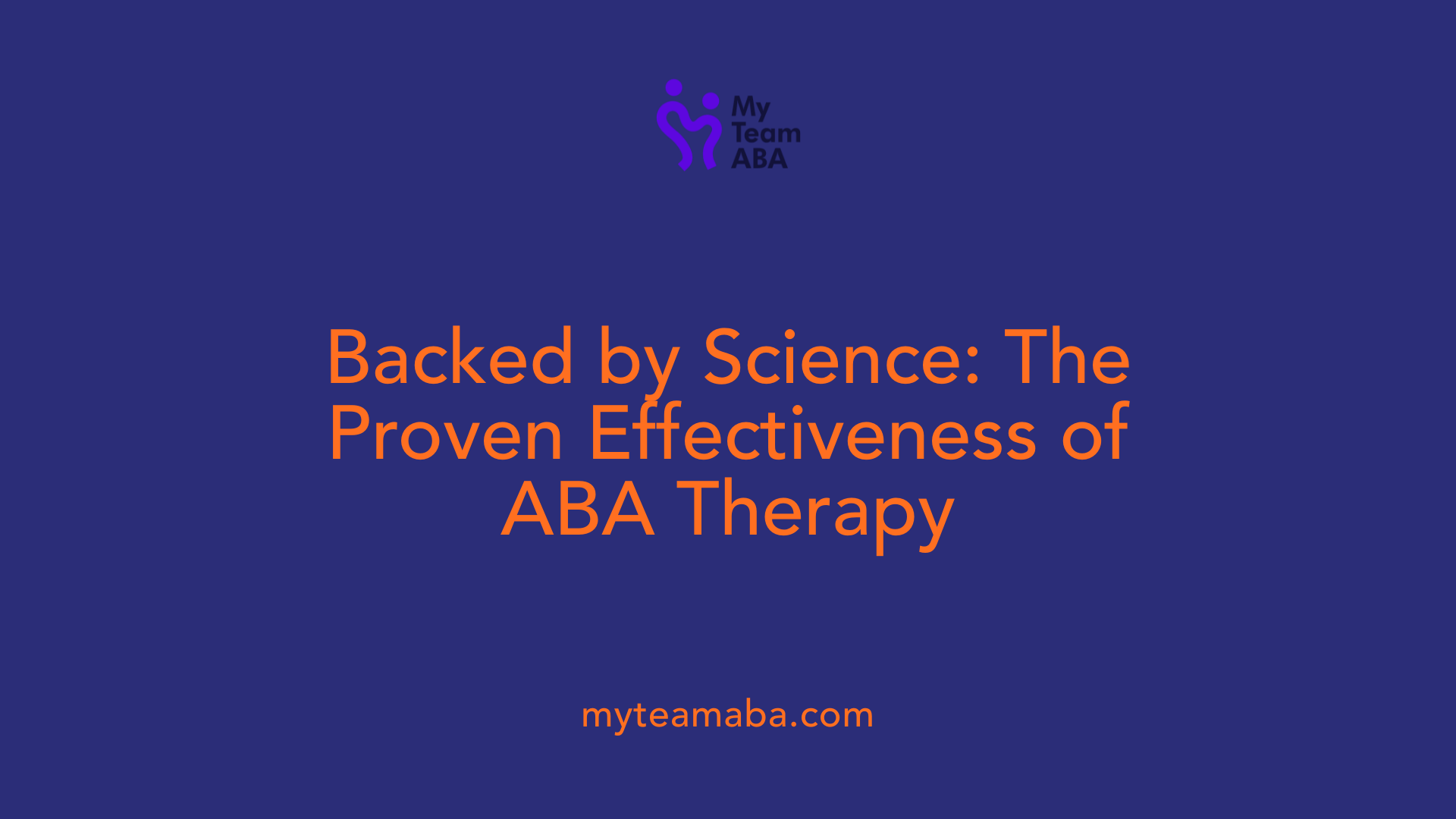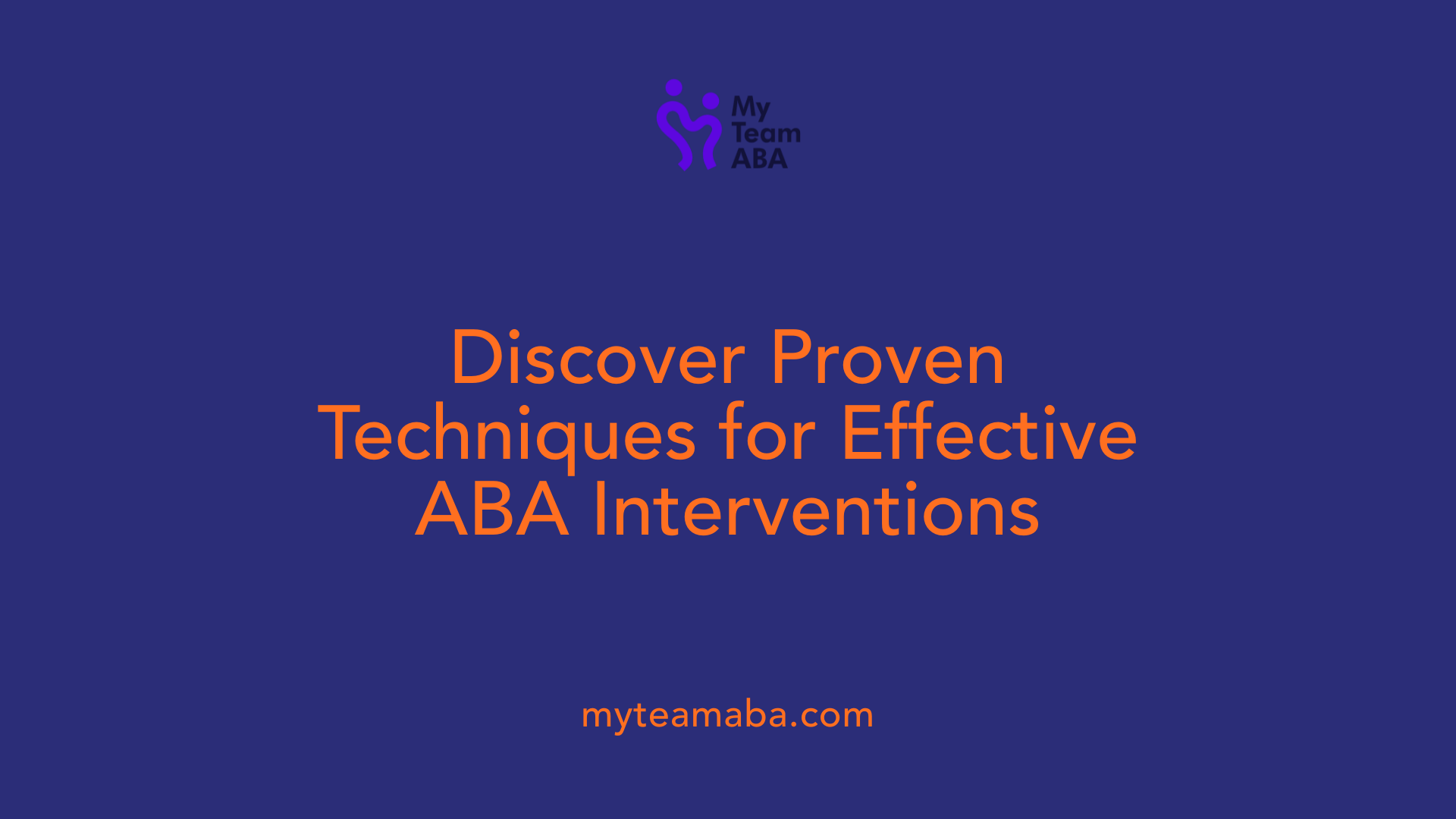The Benefits of ABA Therapy for Behavioral Challenges in Children
November 2, 2025
Unlocking Potential: How ABA Therapy Transforms Children's Lives

Understanding ABA Therapy and Its Core Principles
Applied Behavior Analysis (ABA) therapy is a scientifically validated, personalized approach that helps children with autism and other developmental challenges develop vital skills and reduce problematic behaviors. Grounded in behavioral science, ABA utilizes reinforcement, data collection, and skill-building strategies to foster meaningful improvements across various areas of a child's life. This article explores the core principles of ABA, its proven benefits, and practical insights for parents and caregivers seeking optimal development support for their children.
What Is ABA Therapy and Its Foundational Principles
What is ABA therapy and what are its core principles?
Applied Behavior Analysis (ABA) therapy is an evidence-based approach designed to understand and promote positive behavioral changes in children, especially those with autism spectrum disorder (ASD). It draws on principles from psychology and behaviorism to teach social, communication, and daily living skills, while reducing challenging behaviors.
At its core, ABA uses reinforcement techniques—both positive and negative—to encourage desired behaviors. For example, praise or rewards may be used to motivate children to use words or take turns. Conversely, undesirable behaviors like tantrums can be decreased through carefully planned responses that do not reinforce those behaviors.
The process is guided by the three-term contingency model, which involves:
| Component | Explanation | Example |
|---|---|---|
| Antecedent | The trigger or event before the behavior | A teacher asks a question |
| Behavior | The action or response by the child | The child answers or remains silent |
| Consequence | The outcome that follows the behavior | Praise for an answer, or a timeout |
This model helps determine why behaviors happen and how to modify them effectively.
To personalize interventions, professionals collect detailed data continuously. This data helps in designing tailored treatment plans suited to each child's unique needs. Such plans often include task analysis—breaking complex skills into smaller steps—and use techniques like modeling, prompting, and fading. These methods facilitate skill acquisition and support the generalization of learned behaviors across different environments like home and school.
Overall, ABA aims for meaningful progress in areas such as communication, social skills, and independence. It involves trained specialists who implement structured interventions, track outcomes systematically, and adjust strategies to maximize benefit. Through these methods, ABA helps children develop essential life skills, improve their ability to relate socially, and decrease behaviors that interfere with learning and development.
Significant Benefits of ABA for Children with Autism

What are the main benefits of ABA therapy for children with autism and behavioral challenges?
Applied Behavior Analysis (ABA) therapy provides many advantages for children with autism, especially those facing behavioral difficulties. This scientifically backed approach significantly enhances social, communication, and academic abilities. Through consistent practice, children often become more capable of engaging in typical school and social environments, which can boost their confidence.
One major focus of ABA is teaching essential life skills. These include fundamental daily routines like toileting, dressing, and self-care activities such as brushing teeth and managing personal hygiene. Developing these skills encourages independence, empowering children to perform daily tasks with less reliance on caregivers.
ABA aims to reduce disruptive behaviors such as tantrums, aggression, and self-injury. Using positive reinforcement — rewarding desired behaviors and breaking skills into manageable steps — children learn to respond appropriately to social cues and environmental demands.
Beyond behavior management, ABA nurtures emotional regulation and peer interaction. Through role-playing and modeling, children learn how to take turns, share toys, maintain eye contact, and interpret social signals. These skills foster meaningful peer relationships and support smoother integration into community activities.
Early intervention with tailored ABA programs yields the most significant results. When therapy begins in early childhood—around age 2 or 3—it can lead to substantial improvements in communication, social skills, academic performance, and overall independence.
In summary, ABA therapy helps children with autism develop vital skills that enhance their ability to live independently, interact effectively with others, and participate fully in everyday life. Through evidence-based practices, it supports lifelong growth and improves quality of life for both children and their families.
Supporting Development of Social, Communication, and Self-Help Skills with ABA

How does ABA therapy support the development of social, communication, and self-help skills?
ABA therapy is highly effective in fostering essential life skills in children with autism. It uses a range of tailored techniques to teach children behaviors needed for greater independence. Methods like prompting, modeling, and natural environment teaching help children learn social interactions, communication, and daily routines.
Prompting involves guiding children through steps to perform tasks or respond correctly, gradually fading assistance as independence grows. Modeling provides children with examples of desired behaviors through imitation, making it easier for them to grasp social cues and social skills.
Natural environment teaching (NET) incorporates learning within everyday activities and settings, ensuring skills are applied in real-world contexts. These approaches help children develop skills such as greeting others, sharing toys, making eye contact, and engaging in reciprocal conversations.
Verbal Behavior Therapy (VBT) is a core part of ABA focused on functional language use. It categorizes language into operants such as mands (requests), tacts (labels or comments), and intraverbals (conversational exchanges). Teaching these operants systematically helps children communicate effectively, whether verbally or through alternative systems.
To support communication, ABA employs visual aids like picture exchange systems (PECS), visual schedules, and augmentative and alternative communication (AAC) devices. These tools help nonverbal children express needs and participate socially.
Positive reinforcement, such as praise or rewards, encourages children to practice and maintain learned skills across settings—home, school, and community. Skill generalization is a focus of ABA, ensuring that children apply newly acquired behaviors in various environments.
Family involvement and individualized planning are critical. Therapists assess each child's strengths and challenges, designing personalized intervention plans. Regular data collection tracks progress, allowing adjustments while empowering families with strategies to reinforce skills at home.
Overall, ABA's structured and data-driven approach supports children in developing social competencies, enhancing communication abilities, and gaining independence through targeted, enjoyable learning experiences.
The Scientific Evidence Backing ABA Effectiveness
 Research studies and meta-analyses overwhelmingly support the effectiveness of Applied Behavior Analysis (ABA) as a treatment for children with autism spectrum disorder (ASD). Extensive data from controlled experiments demonstrate that ABA can bring about significant improvements in socialization, communication, and adaptive behaviors.
Research studies and meta-analyses overwhelmingly support the effectiveness of Applied Behavior Analysis (ABA) as a treatment for children with autism spectrum disorder (ASD). Extensive data from controlled experiments demonstrate that ABA can bring about significant improvements in socialization, communication, and adaptive behaviors.
Meta-analyses, which combine results from multiple studies, consistently show small to moderate gains in daily functioning, especially in language development and social skills. For example, research involving large sample sizes indicates that early and intensive ABA therapy—typically over 20 hours per week—can lead to notable progress in critical areas such as expressive language, self-care, and peer interactions.
In addition, several authoritative organizations, including the US Surgeon General and the American Academy of Pediatrics, recognize ABA as an evidence-based practice proven to improve core skills in children with ASD. Studies also show that the impact of ABA therapy correlates with the intensity and duration of treatment, with more than a year of comprehensive intervention resulting in more substantial benefits.
While the evidence confirms ABA’s positive effects, some limitations exist. For instance, the variability in individual responses means some children may experience more significant gains than others. Challenges like maintaining consistent implementation and therapy adherence in real-world settings can also restrict outcomes.
Despite these considerations, the broad consensus among health authorities and research organizations is that ABA remains a scientifically validated approach that effectively promotes social, communication, and independence skills in children with autism.
| Study Type | Findings | Notes |
|---|---|---|
| Controlled Trials | Significant improvements in social and verbal skills | Emphasizes importance of early and intensive intervention |
| Meta-analyses | Moderate gains in daily living and communication | Effective across various age groups and functioning levels |
| Large-scale Studies | Notable progress with treatment duration over 12 months | Higher intensity correlates with better outcomes |
| Endorsements | Supported by US Surgeon General & professional organizations | Recognition as the gold standard treatment for ASD |
Applying evidence from multiple sources, ABA’s success in fostering essential skills underscores its central role in autism intervention strategies.
Techniques and Strategies Employed in ABA Therapy
 ABA therapy incorporates a wide range of techniques and strategies aimed at teaching new skills and shaping positive behaviors. One fundamental method is positive reinforcement, which rewards desirable behaviors to encourage their recurrence. Prompting and fading are also used, where cues are initially provided to encourage correct responses, then gradually withdrawn to foster independence.
ABA therapy incorporates a wide range of techniques and strategies aimed at teaching new skills and shaping positive behaviors. One fundamental method is positive reinforcement, which rewards desirable behaviors to encourage their recurrence. Prompting and fading are also used, where cues are initially provided to encourage correct responses, then gradually withdrawn to foster independence.
Behavior chaining is another core strategy, breaking complex tasks into smaller, manageable steps that are taught sequentially. Modeling and task analysis are crucial for demonstrating desired behaviors and systematically teaching skills. These techniques are often combined in structured ways to create effective learning experiences.
Several specialized methodologies structure ABA intervention. Discrete Trial Training (DTT) involves clear, controlled teaching trials with consistent prompts and reinforcements. Pivotal Response Treatment (PRT) focuses on pivotal areas like motivation and response to multiple cues to produce broader skill development. The Early Start Denver Model (ESDM) integrates play-based, naturalistic teaching techniques suitable for very young children.
In addition to skill acquisition, ABA strategies aim to reduce undesirable behaviors. Extinction involves withholding reinforcement for problematic behaviors, while redirection guides the child toward more appropriate responses. Script fading gradually eliminates prompts and prompts children to use learned language or behaviors independently.
Data collection is a critical aspect of ABA, with ongoing monitoring of behaviors, antecedents, and consequences. This information informs individualized adjustments to therapy plans, ensuring interventions remain responsive to each child's progress and needs. Through careful implementation of these strategies, ABA therapy helps children develop functional skills, improve communication, and increase independence.
Promoting Independence and Overall Development through ABA
Can ABA therapy help children become more independent and support their overall development?
Yes, ABA therapy plays a significant role in helping children with autism become more independent while supporting their overall growth. It employs personalized, scientifically supported strategies to teach vital life skills that include self-care routines like brushing teeth, dressing, and toileting.
Through behavioral techniques such as positive reinforcement, children learn to communicate their needs, follow instructions, and engage in social interactions. These skills are broken down into manageable steps and taught using tools like picture cards, visual schedules, and role-playing, which make learning accessible and fun.
Addressing challenging behaviors such as tantrums, aggression, or self-injury is another core focus of ABA. By identifying triggers and replacing harmful behaviors with functional alternatives, children can navigate daily environments more confidently.
Family participation is vital in ABA therapy. Caregivers are actively involved in training and practicing new skills at home and other settings, ensuring consistency and helping skills to generalize across different environments. This collaborative approach empowers families, reducing stress and strengthening relationships.
Over time, these targeted interventions foster a child's self-reliance and self-confidence. Improved independence in daily routines not only enhances quality of life but also helps children participate more fully in their communities, including social activities, educational settings, and recreational activities.
In summary, ABA therapy supports children in acquiring essential skills and reducing barriers to independence, ultimately enabling them to lead more satisfying lives with increased community involvement.
Guidance for Parents and Caregivers about ABA Therapy

What should parents and caregivers know about ABA therapy?
Parents and caregivers should be aware that Applied Behavior Analysis (ABA) is a scientifically supported, evidence-based approach widely used to help children with autism develop vital skills. ABA focuses on improving communication, social interactions, self-care, and academic skills while also reducing problematic behaviors such as tantrums, aggression, or self-injury.
This therapy operates through structured, individualized programs designed by trained professionals like board-certified behavior analysts (BCBAs). These experts tailor interventions to each child's unique needs, using techniques such as positive reinforcement, modeling, role-playing, and visual aids to teach new behaviors.
The core of ABA involves understanding how behavior is influenced by environment and identifying triggers. It then systematically teaches alternative behaviors in various settings, including home, school, and community. The therapy emphasizes skill development across many areas— from basic daily routines like dressing and toileting to social skills such as sharing, taking turns, and making eye contact.
Parents play a crucial role in this process. They should actively participate by setting goals, practicing techniques learned, and supporting their child's progress outside of therapy sessions. Reviewing data and progress reports helps ensure ongoing effectiveness and makes it possible to adjust strategies as needed.
Research spanning decades shows that intensive ABA programs, especially when started early and with sufficient hours per week, can lead to significant improvements. These improvements include better language and communication skills, greater independence, and enhanced ability to engage with peers.
In summary, ABA therapy offers a structured, flexible, and scientifically validated path to helping children with autism thrive. Understanding its principles and maintaining active involvement can maximize positive outcomes for your child's development and future success.
Embracing the Transformative Power of ABA
ABA therapy stands as a proven, powerful approach for supporting children with autism and behavioral challenges. Its personalized, evidence-based strategies foster the development of critical social, communication, and life skills, ultimately leading to greater independence and improved quality of life. For parents, caregivers, and educators, understanding ABA’s principles and benefits is key to maximizing its potential benefits. Early intervention and consistent collaboration with trained professionals and families can make a profound difference—transforming challenges into opportunities for growth and lifelong success.
References
- 6 Life-Changing Benefits of ABA Therapy for Children with Autism
- Applied Behavior Analysis (ABA) - Cleveland Clinic
- Benefits of ABA Therapy for Children with Autism
- The Top 10 Reasons Children With Autism Deserve ABA - PMC
- How ABA Therapy Improves Social Skills in Children With Autism
- 5 Benefits Of ABA Therapy For Autism - Surpass Behavioral Health
- Patient Outcomes After Applied Behavior Analysis for Autism ...
- 5 Signs Your Child Could Benefit from ABA Therapy
- How ABA Therapy Can Help Children with Behavioral Challenges
- 7 Surprising Benefits of ABA Therapy for Kids You Need to Know
